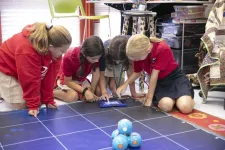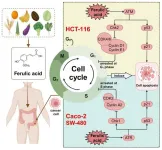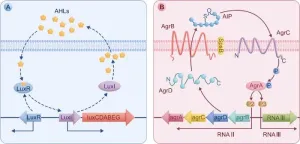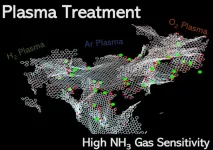(Press-News.org) It is unpleasant to have an enemy. Most people try to avoid hostilities that escalate to the point of mutual antagonism. Which raises the question: What does it take to make an enemy? One possible answer is that aversive or off-putting behaviors increase the likelihood of clashes with others that lead to lasting enmity. Yet without longitudinal data, it’s unclear which comes first – being aversive or being disliked – making it hard to distinguish between the causes and the consequences of having an enemy.
New research from Florida Atlantic University clearly establishes the order of effects. The results, published in the Journal of Youth and Adolescence, indicate that students who behave in unattractive ways at the beginning of the school year are at elevated risk of antagonizing others and becoming involved in enemy relationships by the end of the school year.
The study involved more than 300 Florida students ages 9 to 14 years old attending diverse public primary and middle schools. Students completed surveys at the beginning, middle and end of the school year. At each time point, students identified classmates they disliked. Enemies (also known as mutual antipathies) were defined as dyads in which both partners disliked one another. Students also nominated classmates who did well in school and who were prosocial, as well as those who were aggressive and those who were disruptive. Self-reports described emotional instability and emotional problems.
“Enemies or mutual antipathies occur when two people dislike each other. Ill will needs to be reciprocated. Both parties need to share the same feeling. Mutual antipathies are not very common; less than 5% of students in our study had enemies,” said Brett Laursen, Ph.D., senior author and a professor of psychology within FAU’s Charles E. Schmidt College of Science.
Results of the study found that adolescents with aversive traits at the beginning of the school year were more likely to develop enemy relationships over the course of the school year compared to those without these traits. Emotional reactivity was the strongest risk factor for participation in a mutual antipathy. Emotionally unstable youth were 35% more likely to form enemy relationships than those with low levels of emotional instability. Doing poorly in school, being aggressive and classroom disruptiveness were also strong predictors of later participation in an enemy relationship. Students perceived as not helpful or caring also tended to form mutual antipathies.
Importantly, the risk of developing an enemy relationship remained consistent throughout the school year, and it did not differ on the basis of gender (males versus females) or school grade level (primary versus middle school students), indicating that these behavioral risks are broadly applicable across different groups of adolescents.
“Students who exhibit off-putting behaviors tend to become involved in relationships characterized by mutual disliking. Youth who behave in unattractive ways are disliked and that sentiment is often returned,” said Laursen. “All manners of annoying behaviors can antagonize others. Emotional instability is a particularly challenging trait. Emotionally reactive youth react quickly and intensely to situations, which can easily lead to peer conflicts and escalate negative emotions.”
Poor school performance and acting out in class are also antagonizing.
“School is frustrating for youth who are not academically successful. They may come to resent those who are accomplished and appreciated by teachers. This resentment is often returned,” said Laursen.
Similarly, class disruptions can be irksome to classmates because disruptions sidetrack the class, interfering with the academic attainment of other peers.
“Our findings are important because mutual antipathies have real consequences,” said Laursen. “Troubled youth who make enemies often find themselves trapped in a cycle of social and emotional difficulties. Mutual antipathies can harm group cohesion, making the classroom a less supportive learning environment. More importantly, negative interactions are stressful. For some youth, these conflicts may lead to serious distress, possibly even school avoidance. Taking proactive steps to prevent these conflicts is crucial.”
Study co-authors are Mary Page Leggett-James, a doctoral candidate, and Michael Yoho, Ph.D., a doctoral graduate, both from the FAU Psychology Department.
This research was supported by a grant from the United States National Institute of Child Health and Human Development of the National Institutes of Health (HD096457).
- FAU -
About Florida Atlantic University:
Florida Atlantic University, established in 1961, officially opened its doors in 1964 as the fifth public university in Florida. Today, Florida Atlantic serves more than 30,000 undergraduate and graduate students across six campuses located along the Southeast Florida coast. In recent years, the University has doubled its research expenditures and outpaced its peers in student achievement rates. Through the coexistence of access and excellence, Florida Atlantic embodies an innovative model where traditional achievement gaps vanish. Florida Atlantic is designated as a Hispanic-serving institution, ranked as a top public university by U.S. News & World Report, and holds the designation of “R1: Very High Research Spending and Doctorate Production” by the Carnegie Classification of Institutions of Higher Education. Florida Atlantic shares this status with less than 5% of the nearly 4,000 universities in the United States. For more information, visit www.fau.edu.
END
Colon cancer continues to be one of the leading causes of cancer-related deaths worldwide, with poor dietary habits identified as a major risk factor. Ferulic acid, a phenolic compound abundant in many plant foods, has previously demonstrated potential anti-cancer properties by inhibiting cell proliferation and promoting apoptosis. Despite its promising effects, the impact of ferulic acid on colon cancer cells at different Duke’s progressive stages of the disease has remained largely unexplored. Given the critical need for new preventative measures, understanding the mechanisms through which ferulic acid acts on cancer cells is vital.
Published (DOI: 10.26599/FMH.2025.9420063) ...
Pseudomonas aeruginosa is notorious for its role in food spoilage and infections, posing a significant threat to both food safety and human health. Traditionally, antimicrobial agents have been the go-to solution for managing contamination. However, the overuse of these agents has accelerated the development of drug resistance, leading to the emergence of multidrug-resistant strains that are difficult to treat. In response to this growing concern, the need for alternative methods to mitigate Pseudomonas aeruginosa’s pathogenicity ...
An autonomous underwater vehicle can propel itself efficiently by using the energy in nearby water currents. Underwater and aerial vehicles must make their way through a complex environment of gusts and currents, fighting against many flows as they attempt to stay on course. Peter Gunnarson and John O. Dabiri designed an underwater robot that makes use of these flows to cut down on the energy needed to travel, “surfing” vortices to make its way to its destination. The palm-sized robot, CARL, was equipped with an onboard inertial measurement unit, ten motors to allow movement in all three axes, and a simple but effective algorithm: if ...
Neuroimaging can capture brain activity in response to stimuli before a person decides how to respond. Initial affective responses—broadly good or bad feelings about a stimulus—have been associated with activity in evolutionarily conserved subcortical and cortical circuits including the Nucleus Accumbens (NAcc) and Anterior (AIns). Activity then continues through integrative circuits associated with more deliberative and reflective processing. Previous work has suggested that the early affective responses may be more ...
Ask a Large language model (LLM) such as ChatGPT to summarize what people are saying about a topic, and although the model might summarize the facts efficiently, it might give a false impression of how people feel about the topic. LLMs play an increasingly large role in research, but rather than being a transparent window into the world, they can present and summarize content with a different tone and emphasis than the original data, potentially skewing research results. Yi Ding and colleagues compared a climate dataset of 18,896,054 tweets that mentioned "climate change" from January 2019 to December 2021 to rephrased tweets prepared by LLMs. The authors found that the ...
Gas sensing technologies play a vital role in our modern world, from ensuring our safety in homes and workplaces to monitoring environmental pollution and industrial processes. Traditional gas sensors, while effective, often face limitations in their sensitivity, response time, and power consumption.
To account for these drawbacks, recent developments in gas sensors have focused on carbon nanomaterials, including the ever-popular graphene. This versatile and relatively inexpensive material can provide exceptional sensitivity ...
New research highlighted in the journal CABI Reviews suggests that all five subregions of Africa will breach the 1.5°C climate change threshold – the limit stipulated by the Paris Agreement – by 2040 even under low emission scenarios.
A team of scientists, from the University of Zimbabwe, and the International Livestock Research Institute (ILRI) in Kenya, conducted a literature review to develop a framework for just transition pathways for Africa’s agriculture towards low emission and climate resilient development under 1.5°C of global warming.
They found that despite Africa ...
Investigators from Mass General Brigham have conducted a multi-ancestry, whole genome sequencing association study of Alzheimer’s disease and found evidence for 16 new susceptibility genes, expanding the study of Alzheimer’s disease in underrepresented groups. Their results are published in Alzheimer’s & Dementia: The Journal of the Alzheimer’s Association.
For the study, co-led by Julian Daniel Sunday Willett, MD, PhD, and Mohammad Waqas, of the Genetics and Aging Research ...
A new definition of dyslexia is needed to more accurately describe the learning disorder and give those struggling with dyslexia the specific support they require, says new research.
Dyslexia has had several different definitions over the years and this murky and complicated history means it can be a postcode lottery for children who may have dyslexia, or those who have been diagnosed but can’t access the support they need.
The first step to fixing this issue, new research has argued, is to redefine dyslexia and adopt the new definition across the UK.
The research was conducted by the University of Birmingham, the SpLD Assessment Standards Committee (SASC), Kings College London, ...
More than half of women ages 30 to 35 are already suffering moderate to severe symptoms associated with menopause, yet most women are waiting decades before seeking treatment, new research from UVA Health and the Flo women’s health app reveals.
The research sheds important light on “perimenopause,” the transition period leading to menopause. Many women in perimenopause assume they’re too young to be suffering symptoms related to menopause, believing that symptoms won’t appear until they reach their 50s. But this ...




